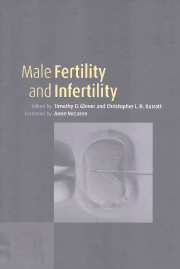Book contents
- Frontmatter
- Contents
- List of contributors
- Foreword by Anne McLaren, FRS
- Preface
- Acknowledgements
- Part 1 Biological perspectives
- Part 2 Implications of the new technologies
- 8 ICSI: the revolution and the portents
- 9 The genetic basis of male infertility
- 10 The treatment of azoospermia with surgery and ICSI
- 11 The challenge of asthenozoospermia
- 12 Molecular techniques for the diagnosis of inherited disorders and male reproductive malfunction
- 13 Gazing into the crystal ball: future diagnosis and management in andrology
- Index
12 - Molecular techniques for the diagnosis of inherited disorders and male reproductive malfunction
from Part 2 - Implications of the new technologies
Published online by Cambridge University Press: 09 August 2009
- Frontmatter
- Contents
- List of contributors
- Foreword by Anne McLaren, FRS
- Preface
- Acknowledgements
- Part 1 Biological perspectives
- Part 2 Implications of the new technologies
- 8 ICSI: the revolution and the portents
- 9 The genetic basis of male infertility
- 10 The treatment of azoospermia with surgery and ICSI
- 11 The challenge of asthenozoospermia
- 12 Molecular techniques for the diagnosis of inherited disorders and male reproductive malfunction
- 13 Gazing into the crystal ball: future diagnosis and management in andrology
- Index
Summary
Introduction
Traditionally reproductive medicine has often relied upon whole sample biochemical assays and scanning procedures to determine genetic disorders and reproductive malfunction. However, in recent years, molecular biological techniques have advanced, resulting in a rapid increase in diagnostic methods that are highly applicable to the assessment and treatment of genetic disorders associated with reproductive medicine. These molecular advances, in combination with assisted-reproductive treatments, such as intracytoplasmic sperm injection (ICSI), have resulted in alternative treatment options and a broadening of our knowledge of reproductive processes.
The aim of this chapter is to give a broad overview of the current methods used to diagnose inherited disorders and male reproductive malfunction and those techniques employed in other fields that could be adopted for these purposes. The diagnostic measures used are discussed first, followed by the diagnosis of inherited disorders and an overview of the different disorders. Then follows a description of how molecular techniques are applied in the investigation of male reproductive malfunction.
Molecular techniques
Karyotyping
Although karyotyping is not a molecular technique as such, its importance in diagnosing inherited disorders cannot be underestimated. Karyotyping involves analysis of cells for their chromosome number and structural anomalies. The cells are arrested in metaphase and stained to reveal characteristic banding patterns that allow the detection of structural defects. Karyotyping still remains the method of choice for diagnosing gross chromosomal abnormalities, especially for some patients who harbour chromosomal abnormalites, for example those with Turner's syndrome.
- Type
- Chapter
- Information
- Male Fertility and Infertility , pp. 213 - 247Publisher: Cambridge University PressPrint publication year: 1999

